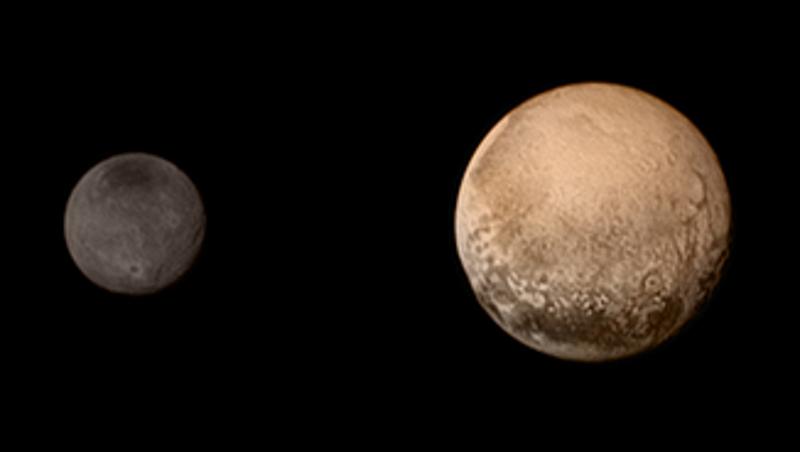
It's Earth's least-known neighbour but tomorrow's first-time flyby of Pluto will forever change how we view our galactic neighbourhood.
Launched back in January 2006, NASA's New Horizons spacecraft will make its closest approach to Pluto at around 8.45pm AEST tonight.
It's the first time humanity has sent a probe to study the dwarf planet, and the first chance in a quarter of a century for humanity to study a new class of world.
QUT astrophysicist Dr Stephen Hughes said New Horizons had been beaming the first-ever colour images of Pluto back to Earth since April, when it was still 115 million km away.
"Who'd have guessed a snowball like Pluto would actually be a reddish colour?" said Dr Hughes, from QUT's Science and Engineering Faculty.
"Pluto's colour is quite similar to the reddish brown of Mars.
"But unlike Mars, which is literally covered in rust, Pluto's colouring is thought to be due to chemicals called tholins, produced when nitrogen and methane in Pluto's tenuous atmosphere reacts with ultraviolet radiation.
"More recent images have shown some interesting features, including a long, dark shape that's been dubbed 'the whale'.
"Other images of Pluto's moon Charon have shown us a newly-discovered system of chasms that are larger than the USA's Grand Canyon."
Dr Hughes said New Horizons was the fastest spacecraft ever built and would pass Pluto at a speed of 49,600 km/hour, or 14 km/s.
"That's more than 10 times faster than a rifle bullet. At that speed, you could fly around the world in 30 minutes!" he said.
Pluto is the last of the "classical nine" planets to be studied up close. New Horizons' mission team boasts that it is carrying the most powerful suite of science instruments ever used to study a planet for the first time.
It will collect a flood of images and data from the dwarf planet as it flies past.
This is an important mission for NASA as it represents a chance to study an entirely new class of world - neither a rocky planet like Mercury, Venus, Earth and Mars, nor a gas giant like the Solar System's outer planets.
Instead, Pluto resembles many other objects in the Kuiper belt, a ring of icy bodies that extends beyond Neptune's orbit.
"The Kuiper belt is similar to the asteroid belt between Mars and Jupiter, only much, much larger," said Dr Hughes.
"It could be home to as many as a billion icy bodies that are 10km in diameter or more.
"We believe these objects were made of the same material that formed into the Solar System's eight official planets but for some reason the Kuiper belt material stopped forming into planets quite early in the system's history.
"After flying past Pluto, New Horizons will pass through the Kuiper belt and visit some of these bodies.
"Studying them and Pluto should give us some fantastic insights into our system's distant past and help us understand more about the chemical ingredients of all the planets."
The New Horizons flyby comes 85 years after Pluto was discovered in 1930 by Clyde Tombaugh at Arizona's Lowell Observatory.
With a radius of 1,184 km, the dwarf planet is about half the size of Australia.
Dr Hughes said Pluto is currently more than 30 times farther away from the Sun than the Earth is from the Sun.
"Since the mass of Pluto is only 0.2 per cent of Earth's mass, gravity there is so weak that if you dropped a glass in a kitchen on Pluto it would take 1.9 seconds to hit the floor, compared to 0.45 seconds here on Earth.
"That glass on Pluto would hit the floor at only one-tenth the speed it would on Earth.
"Pluto is extremely cold, with a winter low of -240 °C and summer high of -218 °C.
"It's so far away from the Sun that the midday landscape is about as bright as it is four minutes after sunset in Brisbane. Sunglasses would not be required on Pluto."
RELATED STORIES
MEDIA ADVISORY: QUT astrophysicist can comment on Venus-Jupiter double act
A simple siphon could help mitigate damage from future earthquakes in Nepal
Catch Mother Nature's third act - expert available on 4 April lunar eclipse
Media contact:
Kate Haggman, QUT Media, 07 3138 0358, kate.haggman@qut.edu.au
After hours Rose Trapnell, QUT Media team leader, 0407 585 901.


